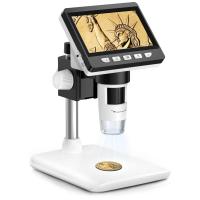What Discoveries Have Been Made Using Microscopes ?
Microscopes have played a crucial role in numerous scientific discoveries. They have allowed scientists to observe and study the microscopic world, leading to significant advancements in various fields. Some notable discoveries made using microscopes include:
1. Cell Theory: In the 17th century, the invention of the compound microscope enabled scientists like Robert Hooke and Antonie van Leeuwenhoek to observe and describe cells for the first time. This led to the development of the cell theory, which states that all living organisms are composed of cells.
2. Germ Theory: Microscopes played a pivotal role in the discovery of microorganisms and the development of the germ theory of disease. Scientists like Louis Pasteur and Robert Koch used microscopes to identify bacteria and other pathogens, revolutionizing our understanding of infectious diseases.
3. DNA Structure: The discovery of the double helix structure of DNA by James Watson and Francis Crick in 1953 was made possible through X-ray crystallography, which relies on the use of microscopes to analyze the diffraction patterns of X-rays.
4. Nanotechnology: Microscopes equipped with advanced imaging techniques, such as scanning tunneling microscopy and atomic force microscopy, have allowed scientists to manipulate and study matter at the nanoscale. This has led to breakthroughs in nanotechnology, enabling the development of new materials and devices with unique properties.
These are just a few examples of the many discoveries made using microscopes. The ability to magnify and visualize the microscopic world has undoubtedly revolutionized scientific research across various disciplines.
1、 Cell structure and organelles
Microscopes have played a crucial role in advancing our understanding of cell structure and organelles. Through the use of microscopes, scientists have made numerous discoveries that have revolutionized our knowledge of the microscopic world.
One of the most significant discoveries made using microscopes is the existence of cells themselves. In the 17th century, Robert Hooke observed cork under a microscope and coined the term "cell" to describe the small compartments he saw. This discovery laid the foundation for the field of cell biology and led to the understanding that all living organisms are composed of cells.
Microscopes have also allowed scientists to identify and study various organelles within cells. For example, in the 19th century, the development of more advanced microscopes enabled the visualization of structures such as the nucleus, mitochondria, and Golgi apparatus. These discoveries provided insights into the functions and roles of these organelles in cellular processes.
In recent years, advancements in microscopy techniques have further expanded our understanding of cell structure and organelles. For instance, the development of super-resolution microscopy has allowed scientists to visualize cellular structures with unprecedented detail. This technique has revealed intricate details of organelles, such as the arrangement of proteins within the mitochondria or the dynamics of membrane fusion in the endoplasmic reticulum.
Furthermore, the use of electron microscopy has provided insights into the ultrastructure of cells and organelles. By using a beam of electrons instead of light, electron microscopes can achieve much higher resolution, allowing scientists to observe cellular structures at the nanoscale. This has led to the discovery of new organelles, such as peroxisomes and lysosomes, and has provided a deeper understanding of their functions.
In conclusion, microscopes have been instrumental in uncovering the intricacies of cell structure and organelles. From the initial discovery of cells to the recent advancements in super-resolution and electron microscopy, these tools have allowed scientists to explore the microscopic world and gain insights into the fundamental building blocks of life.
2、 Microorganisms and their role in disease
Microscopes have played a crucial role in the field of microbiology, enabling scientists to make significant discoveries about microorganisms and their role in disease. Through the use of microscopes, scientists have been able to observe and study microorganisms at a cellular level, leading to groundbreaking findings.
One of the most significant discoveries made using microscopes is the identification of various disease-causing microorganisms. For example, the discovery of bacteria such as Escherichia coli, Salmonella, and Staphylococcus aureus has revolutionized our understanding of infectious diseases. Microscopes have allowed scientists to observe the morphology, structure, and behavior of these microorganisms, providing valuable insights into their pathogenicity and mechanisms of infection.
Furthermore, microscopes have been instrumental in the discovery of viruses, which are smaller and often more elusive than bacteria. The visualization of viruses such as the influenza virus, human immunodeficiency virus (HIV), and severe acute respiratory syndrome coronavirus 2 (SARS-CoV-2) has been crucial in understanding their structure, replication, and transmission. This knowledge has been pivotal in the development of vaccines and antiviral therapies.
In recent years, advancements in microscopy techniques have further expanded our understanding of microorganisms and their role in disease. For instance, the development of electron microscopy has allowed scientists to visualize microorganisms at an even higher resolution, providing detailed insights into their ultrastructure. Additionally, fluorescence microscopy techniques have enabled the visualization of specific molecules within microorganisms, aiding in the study of their metabolic processes and interactions with host cells.
Moreover, the use of advanced microscopy techniques, such as confocal microscopy and super-resolution microscopy, has allowed scientists to study microorganisms in real-time and three-dimensional space. This has provided a deeper understanding of the dynamic behavior of microorganisms within their natural environments, including their interactions with host tissues and immune cells.
In conclusion, microscopes have been instrumental in the discovery and understanding of microorganisms and their role in disease. From identifying disease-causing bacteria to visualizing viruses and studying their behavior, microscopes have revolutionized our understanding of infectious diseases. With ongoing advancements in microscopy techniques, we can expect further discoveries that will enhance our ability to combat and prevent microbial diseases.
3、 DNA and genetic material
Microscopes have played a crucial role in numerous scientific discoveries, particularly in the field of DNA and genetic material. The ability to observe and analyze microscopic structures has revolutionized our understanding of genetics and has led to significant advancements in various areas of biology and medicine.
One of the most groundbreaking discoveries made using microscopes was the identification of DNA as the hereditary material. In the early 1950s, James Watson and Francis Crick used X-ray crystallography data, which required the use of microscopes, to propose the double helix structure of DNA. This discovery laid the foundation for our understanding of how genetic information is stored and transmitted.
Microscopes have also been instrumental in studying the structure and function of genes. Through techniques such as fluorescence in situ hybridization (FISH), researchers can visualize specific genes or DNA sequences within cells or tissues. This has allowed for the identification of gene mutations, gene expression patterns, and the localization of genes within chromosomes.
Furthermore, microscopes have been crucial in studying the behavior of chromosomes during cell division. By using techniques like fluorescence microscopy and live-cell imaging, scientists have been able to observe the intricate process of DNA replication, chromosome segregation, and the formation of the mitotic spindle. These observations have provided valuable insights into the mechanisms of cell division and the maintenance of genomic stability.
In recent years, advancements in microscopy techniques have further expanded our understanding of DNA and genetic material. Super-resolution microscopy, for example, has allowed scientists to visualize structures at the nanoscale level, providing unprecedented detail of DNA organization within the nucleus. Additionally, single-molecule imaging techniques have enabled the direct observation of individual DNA molecules, revealing dynamic processes such as DNA repair and transcription.
In conclusion, microscopes have been instrumental in numerous discoveries related to DNA and genetic material. From the identification of DNA as the hereditary material to the visualization of gene expression patterns and the observation of chromosome behavior, microscopes have revolutionized our understanding of genetics. Continued advancements in microscopy techniques will undoubtedly lead to further breakthroughs in this field, allowing us to unravel the complexities of DNA and genetic material even further.
4、 Nanotechnology and materials science
Microscopes have played a crucial role in advancing our understanding of nanotechnology and materials science. By enabling scientists to observe and manipulate matter at the nanoscale, microscopes have led to numerous discoveries and breakthroughs in these fields.
One significant discovery made using microscopes is the ability to visualize and manipulate individual atoms and molecules. Scanning tunneling microscopes (STM) and atomic force microscopes (AFM) have allowed scientists to directly observe and manipulate atoms on surfaces, leading to the development of nanoscale devices and materials. For example, the discovery of graphene, a single layer of carbon atoms arranged in a hexagonal lattice, was made possible through the use of microscopes.
Microscopes have also been instrumental in understanding the properties and behavior of materials at the nanoscale. By observing materials at such small dimensions, scientists have discovered unique properties that differ from their bulk counterparts. For instance, the discovery of quantum dots, tiny semiconductor particles with size-dependent optical and electronic properties, has opened up new possibilities in areas such as solar cells, LEDs, and medical imaging.
Furthermore, microscopes have facilitated the study of nanomaterials and their applications. By visualizing the structure and composition of nanomaterials, scientists have been able to design and engineer materials with enhanced properties. For example, the development of superconducting materials with high critical temperatures was made possible through the use of microscopes to understand the underlying atomic structure.
In recent years, advancements in microscopy techniques have allowed for even more precise and detailed observations. For instance, the development of high-resolution transmission electron microscopy (HRTEM) has enabled scientists to directly image individual atoms and defects in materials. This has led to the discovery of new phenomena and the design of novel materials with tailored properties.
In conclusion, microscopes have been instrumental in the discoveries made in the fields of nanotechnology and materials science. From visualizing and manipulating individual atoms to understanding the unique properties of nanomaterials, microscopes have revolutionized our understanding of matter at the nanoscale. With continued advancements in microscopy techniques, we can expect further discoveries and innovations in these fields.





























There are no comments for this blog.